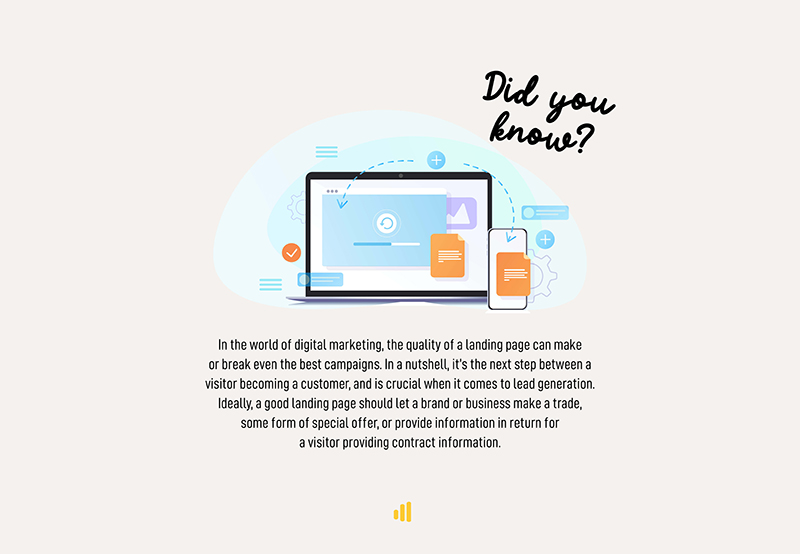Creating a landing page that both looks good, is properly optimised AND gets real results can be somewhat of a fine art – so what do beginners need to know?
If you’re a brand or business trying to make your mark online, at some point most people start to experiment with online advertising, particularly relevant for “pay per click” style marketing such as GoogleAds. However, if you’ve been left scratching your head as to why a campaign might have received hundreds of clicks, but no sales, sign ups or conversions, then the culprit is often a lacklustre landing page.

In the world of digital marketing, the quality of a landing page can make or break even the best campaigns. In a nutshell, it’s the next step between a visitor becoming a customer, and is crucial when it comes to lead generation. Ideally, a good landing page should let a brand or business make a trade, some form of special offer, or provide information in return for a visitor providing contract information.
In simple terms, a landing page is essentially an extension of any promises or glitzy pitches that you might have already made to an audience member in the initial advertisement. To ensure that the customer’s journey stays on track and doesn’t fall flat, what do the very best types of landing pages all have in common?
What The Best Landing Pages All Have In Common
The ultimate end goal of any landing page is to build pages that your target audience engage with, so you can drive more leads through paid search. The very best types of landing pages are properly optimised to be in line with the user’s search intent and give your website an SEO boost, while still being engaging without feeling like “click bait”.
Basically, your landing page should almost read like an organic blog post, while still featuring some form of call to action to drive lead generation, sign ups or sales – but how exactly does one do that?
Have A Clear Purpose – Before you start creating your landing page, ask yourself what the end goal looks like – do you want to expand your email subscription list, want audiences to download a price list, or even issue a discount code? Sometimes it’s easier to start from the end and work backwards towards the beginning, as this will help to define the layout of your landing page.
Have A Strong Headline – The internet is a crowded place, particularly at the top of the Google search engine results and of course over on social media. As a result, you only get one shot to capture the attention of a potential new client, usually in sixty characters or less. Aim to craft a headline that is to the point, while still being enticing enough to get someone to click.

Keep It Relatively Simple – The average session duration on a landing page for desktop users is 150 seconds, decreasing to just 72 seconds for mobile users. Thus, landing pages usually tell a simple story, and they do so quickly so that the visitor gets his or her questions answered in a timely fashion. In turn, be sure to write your landing page while keeping this in mind.
Write For SEO – SEO friendly landing pages are those optimized for search engines, with features that make it particularly appealing to the algorithms that decide whether or not a page is valuable to searchers. As most marketing campaigns are relatively short, people assume it’s not necessary to optimize landing pages, but this can actually help you to gain visitors for free.
Use Testimonials – It’s important to remember that a landing page is often the first time an audience member interacts with your brand or business. If it’s not appropriate to include any reviews or testimonials, you need to give them a reason as to why you’re a worthy candidate for them to buy something from, or for them to hand over their contact details.
Arguably, one of the most important features of any landing page is the content itself. The information you include and how you choose to present this data to new audience members is crucial if you want to see a decent return on your investment. This is particularly relevant considering that landing pages are often used as the backbone of a paid marketing campaign. However, if this form of technical writing isn’t necessarily your strong point, then it might be time to consider outsourcing to the professionals – but where do you find them?
The Key To Good Marketing Is Great Content
Producing quality, consistent and on brand content takes time, effort, experience and resources. Rest assured, you’re not alone if you can’t quite commit to that. However, avoiding content marketing for business altogether may actually be doing your brand a disservice. Thankfully, investing in a solid strategy for online success has never been easier.
Here at Content Hive, producing top quality digital content is exactly what we do best. We have itemised a list of digital content services, and allocated credits next to each of these. This means that each month, you can use your credits with us to produce digital content such as blog articles, social media posts, videos and even animated Instagram stories. By using this model, we believe that it enables us to produce high quality content with faster delivery times. It also means that because you have a monthly credit, you are going to want to make sure you use these up – and so do we – meaning that your digital content is always consistent.
If you aren’t quite sure where to start on your digital marketing journey and would like to speak to a professional, why not book in a free discovery call with us at Content Hive today to discuss how we can get your brand buzzing online.


